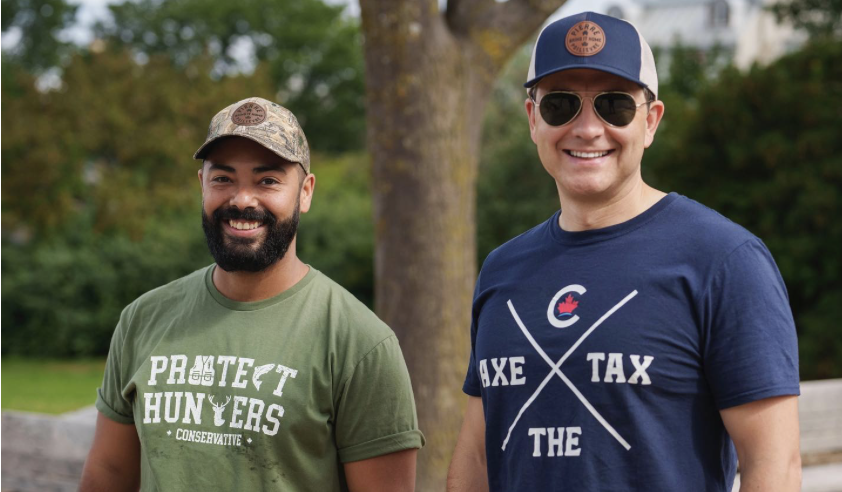The days of hefty donations to political parties and candidates are long gone. Also gone are the days of buttons and bumper stickers, emblazoned with the names of candidates, their party logos and their slogans, being the only merchandise.
As the big three federal parties prepare for the next election, scheduled for Oct. 20, 2025, their marketing strategists have adopted more sophisticated, direct-to-consumer tactics to reach younger voters and their wallets.
“The old model is, frankly, worn out,” said Lindsay Meredith, professor emeritus of marketing at Simon Fraser University. “‘Give me money, I'm a nice guy, we're a good party.’ That’s gotten a little boring. So what we're looking for is, ‘Give me the damn money, but I'll give you a gimmicky reason to hand it over.’”
On Feb. 22, the NDP sent supporters an email, urging them to donate and enter a contest for a trip to Ottawa to meet leader Jagmeet Singh.
“My team has put together a fun new way to combine some of my favourite things — connecting with people and going out for ice cream,” Singh said in the solicitation.
Donate by Feb. 29 and be automatically entered for a March 4 draw for a round trip for two to the national capital and two nights’ accommodation. “Approximate retail value of all prizes: $1,500,” the fine print said.
No contribution was necessary to enter or win. Contributing to the party, it said, would not increase chances of winning. All Canadian citizens and permanent residents currently in Canada were eligible, but not for any officers, employees and family members of the New Democratic Association of Canada, and provincial and territorial wings.
The contest came shortly after Conservative Leader Pierre Poilievre’s edgy “WTF” comment in question period on Feb. 14. Speaker Greg Fergus rose to reprimand Poilievre, who explained it really meant “where’s the funds?” in reference to the $258 million in payments to ArriveCan app contractor GC Strategies.
Poilievre’s team quickly turned that clip into the limited edition, $35 “WTF" T-shirt designed by wife Anaida Poilievre, for sale on the party’s BringItHome.ca website.
“By buying this shirt you join Common Sense Conservatives’ call for a complete and thorough investigation [into the ArriveCan app scandal] to understand how millions were wasted, hold the guilty parties responsible, and scrap this disastrous app once and for all,” said the online catalogue.
The same site sells $30 toques, camouflage baseball caps and a line of other T-shirts, with slogans such as “Axe the Tax,” “Fire the Gatekeepers” and “Protect Hunters.”
The previous special edition T-shirt was emblazoned “How Do You Like Them Apples?” with the image of Poilievre munching an apple during last October’s viral interview in an Oliver, B.C., orchard.
The marketing strategy helped the Conservatives raise a record $35.23 million last year from 200,000 donors, according to Elections Canada figures. More than the Liberals ($15.6 million) and NDP ($6.86 million) combined.
The Conservatives are playing catch-up to the federal Liberals, which sells branded merchandise through Brymark Promotions.
Prime Minister Justin Trudeau is fond of saying diversity is strength. T-shirts and caps are the tip of the iceberg on the online Liberal Boutique, which flogs a $25 mobile phone charging battery, $36 kitchen apron, $29 golf ball dimpled mug, $45 backpack and $15 Liberal sock, in red and black.
That is not a mistake. The crew length sock is sold singular.
Meredith said sales of branded goods do more than bring money to the party to fight the next election.
“What a great deal? The consumer is forking over money, so they can advertise the guy's product for him,” he said.
“You're looking at political parties, if you will, as kind of identification. Just like you're a Canucks fan, or you’re a Maple Leafs fan or whatever.”
But, just like an NHL team, the brand can suffer if the leader performs poorly or breaks rules.
Elections Canada noticed the evolution in political marketing during the first full year of the Liberal majority. In September 2016, it issued an interpretation note intended to clarify the rules for providing a benefit in exchange for a political contribution.
“When a branded good is sold for more than its fair market value (i.e. more than the amount the political entity paid a commercial provider for the item), the purchaser is making a political contribution,” the Elections Canada’s note states.
If a party sold, for example, a $15 party-branded coffee mug that it purchased for $5, the contribution made by each individual buyer is $10.
Expenses incurred to produce and distribute promotional materials that are distributed during an election period must be recorded as election expenses. Rules about contests come into play when there is a price attached to the ticket.
“An individual who purchases a ticket for a draw for the chance to win property or a service is making a contribution equal to the ticket price,” Elections Canada states. “A pro-rated portion of the prize value is not deducted from the ticket price because a value cannot be attached to the hope of winning.”





